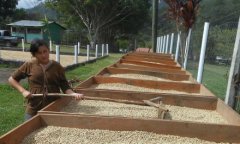The basic introduction of South African Coffee the characteristics of South African coffee the quality of South African coffee the style of South African coffee
The country's coffee trees originated in Kenya and are of excellent quality. Only 1000 hectares of arable land was used to grow coffee trees in 1975, but a new nine-year plan was developed in 1987 to expand the area of arable land, resulting in an additional 6000 hectares of arable land.

Coffee producing areas in South Africa:
Coffee production in South Africa (SouthAfrica) is mainly concentrated in the northeast of the country, from Natal between Lesotho and Mozambique, extending northward to Transvaal, with the southernmost limit of latitude 30 degrees south; further south, coffee cannot be grown due to the harm of early frost. Interestingly, the fruit from the country's coffee trees is more like Central American coffee beans (while Kenya is the origin of the tree), with a fragrant flavor and less acidity.
The characteristics of South African coffee:
South African coffee has a strong aroma and belongs to a variety with low acidity. It is one of the best quality coffee in the world.
Flavor: aromatic, low acidity
Suggested baking method: low to moderate baking
★: general
South African coffee market:
South Africa's top coffee is rare, with a few hundred dollars a pound.
Important Notice :
前街咖啡 FrontStreet Coffee has moved to new addredd:
FrontStreet Coffee Address: 315,Donghua East Road,GuangZhou
Tel:020 38364473
- Prev

The basic introduction of Sudanese Coffee the characteristics of Sudanese coffee the quality of Sudanese coffee the style of Sudanese coffee
Two decades of disastrous civil war in southern Sudan has claimed millions of lives and caused untold damage to rural areas, including the coffee industry. Historically, Arabs shipped black people from southern Sudan to Arabia as slaves, and slaves took coffee beans with them to satisfy their hunger. It is said that these coffee beans were introduced into Yemen as a result. That's right
- Next

Tanzania Coffee introduces the characteristics of Tanzanian Coffee Tanzania Coffee quality Tanzania
Due to political instability and rampant diseases and insect pests, the coffee industry in Tanzania has been damaged, leading to a decline in the overall level of coffee and instability in quality, which in turn lead to lower prices, which are usually the result of a further decline in the coffee industry. What's more, it is estimated that more than 12% of the Arabica coffee grown in northern Tanzania from 1969 to 1985 was smuggled.
Related
- Does Rose Summer choose Blue, Green or Red? Detailed explanation of Rose Summer Coffee plots and Classification in Panamanian Jade Manor
- What is the difference between the origin, producing area, processing plant, cooperative and manor of coffee beans?
- How fine does the espresso powder fit? how to grind the espresso?
- Sca coffee roasting degree color card coffee roasting degree 8 roasting color values what do you mean?
- The practice of lattes: how to make lattes at home
- Introduction to Indonesian Fine Coffee beans-- Java Coffee producing area of Indonesian Arabica Coffee
- How much will the flavor of light and medium roasted rose summer be expressed? What baking level is rose summer suitable for?
- Introduction to the characteristics of washing, sun-drying or wet-planing coffee commonly used in Mantenin, Indonesia
- Price characteristics of Arabica Coffee Bean Starbucks introduction to Manning Coffee Bean Taste producing area Variety Manor
- What is the authentic Yega flavor? What are the flavor characteristics of the really excellent Yejasuffi coffee beans?

